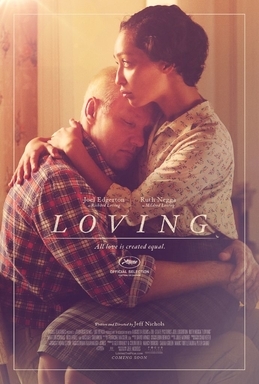 Jeff Nichols wrote and directed "Loving," based on the story of the inter-racial couple whose case led to the Supreme Court's 1967 decision invalidating state laws that restricted marriage to people of the same race.
Jeff Nichols wrote and directed "Loving," based on the story of the inter-racial couple whose case led to the Supreme Court's 1967 decision invalidating state laws that restricted marriage to people of the same race.
Nichols, one of the most acclaimed filmmakers of his generation ("Mud," "Take Shelter," "Midnight Special"), said in an interview that was captivated when he saw "The Loving Story," the documentary about the case.
I just immediately was attached to Richard and Mildred when I saw this beautiful archive of footage, these great photographs. I wanted to hang out with them. I wanted to see what they were doing. I wanted to see right around the edge of that documentary filmmaker's camera.
Some people might focus on the crusading lawyers and political pressures, but Nichols was committed to telling the story of Richard and Mildred Loving, who just wanted to make a home together and care for their family.
When you decide as a storyteller and as a filmmaker to attach yourself to a point of view, certain rules come along with that. We aren't going to leave these people to go follow what is a very fascinating court case. They weren't there. If they were in the day-to-day machinations of the court case then we would've been there, but they weren't. And something interesting happens as a result of that. You're following two people whose life is attached to the outcome of this thing that they do not know, that they are not really a part of, a system that they do not fully understand. There's drama that is in that but also there's a bigger reflection, which is as fascinating as the technicalities are of that court case.
All of it is in service of a bigger idea. The legal system is in service of people and that's what I think people need to be reminded of. As I'm researching this, even though I knew the court case would be in a periphery because of the point of view chosen, I started learning everything about it and you just read: Loving v. Virginia, Loving v. Virginia, Loving v. Virginia, over and over again in this italic font and it almost takes the meaning out of the word. It certainly removes it from Richard and Mildred Loving and I think this story needed to reclaim a little bit of that.
Nichols wanted to show the strength of the Lovings' partnership, their tenderness and deep connection. They were a quiet, private, modest couple from a small town in Virginia who never wanted to be famous.
But even in the throes of the cult of the domesticity in the late 50s and 60s, you have this couple that should fit in the most traditionalist form possible and it just speaks that idea that traditional form of sexual partnership really doesn't apply here, maybe it never did. There is support from both of these people that if you took one of them away the other couldn't survive.
As in Nichols' other films, "Loving" has a strong and evocative sense of place and its portrayal of the countryside is textured and vibrant.
Central Point is a community outside of Bowling Green, which is the county seat. To call Central Point a town is giving it too much population. But it was a unique place I believe from my research, from the documentary, from talking to people, and also from going there and looking at people. This is a place where racial mingling had been happening for a very long time. In fact, Mildred says in the documentary, "People have been mixing for a long time so we didn't think anything was wrong with it." That's her quote. And you had racial mingling between the black community, the white community and Native American community. She was part Native American so there was a lot going on but the effect on the social relationships is really important to this story because I believe it allowed space for Richard and Mildred to actually fall in love as an honest sincere act, not as an act of defiance or symbolic of something.
I genuinely don't think they were pushing against something. I don't think they were teenagers trying to get back at their parents. I don't think they were making a stand. I genuinely don't believe that from everything I have studied. They were in a unique place in the Jim Crow South of 50s and 60s. There were racist characters like the sheriff, but the fact was that Richard's father worked for a black man. If you think about the psychological impact on young Richard of looking at his family's livelihood being granted by the entrepreneurship of a black man that's a fascinating situation.
And the Central Point setting is about home and family and also nature, something that I have dealt with a lot in my films. This movie is about their relationship to each other but also their relationship to their home. I truly believe that Mildred's character needed nature, she needed the specific place, something in the dirt was very much connected to her soul and that's the only way that you could really explain why someone would move their family back into Virginia to live in hiding, there is no other explanation.
There's that beautiful bookend at the end of the movie, where they return to the plot of land where Richard first said to Mildred, "This is where I'm going to build you a house." The system and everybody else kind of took them away from that. Then they finally, step-by-step, went back there. People living private lives looking to build and protect their private space were dragged out of that place into the public in order to defend their rights, and then they go back to their private place. It's beautiful.
